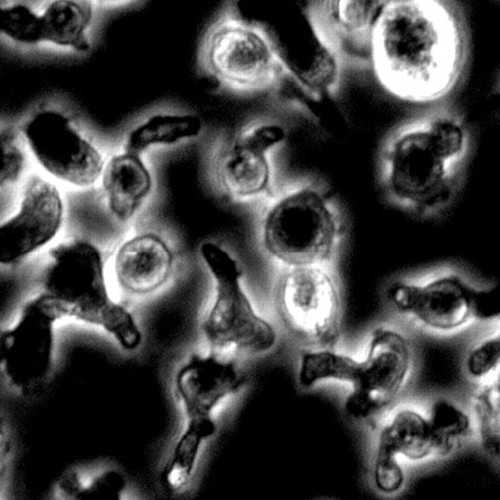Natural Killer Cell Line (KIL)
The Natural Killer Cell Line (KIL) preserves most properties of the normal immature Natural Killer (NK) cells. As such, KIL provides a valuable model system for NK cell research.
Highlights:
- KIL depends on interleukin-7 for survival and proliferation and is NK1.1+ CD3- TCRαβ- TCRδγ- CD4- CD8-CD19- CD25+ CD43+ CD45+ CD49b- CD51+ CD94+ NKG2D+ Mac-1-/low B220-c-kit+ perforin I+ granzyme B+ Notch-1+, and cytotoxic
- Like normal immature natural killer cells, the T-cell receptor-beta loci of KIL remain in the germ-line configuration
- In response to interleukin-2, KIL proliferates extensively (increasing cell number by 10x e10-fold) and terminally differentiates into mature adherent, hypergranular NK cells
Natural killer cells, large granular lymphocytes (LGL) that develop in the bone marrow, are a critical component of the innate immune system that also play a role in the body’s response to cancer and viral infections. NK cells function by releasing granzymes such as perforin to mediate cytotoxicity through apoptosis or cell lysis.
From the laboratory of Schickwann Tsai, MD, PhD, University of Utah.
 Part of The Investigator's Annexe program.
Part of The Investigator's Annexe program.
The Natural Killer Cell Line (KIL) preserves most properties of the normal immature Natural Killer (NK) cells. As such, KIL provides a valuable model system for NK cell research.
Highlights:
- KIL depends on interleukin-7 for survival and proliferation and is NK1.1+ CD3- TCRαβ- TCRδγ- CD4- CD8-CD19- CD25+ CD43+ CD45+ CD49b- CD51+ CD94+ NKG2D+ Mac-1-/low B220-c-kit+ perforin I+ granzyme B+ Notch-1+, and cytotoxic
- Like normal immature natural killer cells, the T-cell receptor-beta loci of KIL remain in the germ-line configuration
- In response to interleukin-2, KIL proliferates extensively (increasing cell number by 10x e10-fold) and terminally differentiates into mature adherent, hypergranular NK cells
Natural killer cells, large granular lymphocytes (LGL) that develop in the bone marrow, are a critical component of the innate immune system that also play a role in the body’s response to cancer and viral infections. NK cells function by releasing granzymes such as perforin to mediate cytotoxicity through apoptosis or cell lysis.
From the laboratory of Schickwann Tsai, MD, PhD, University of Utah.
 Part of The Investigator's Annexe program.
Part of The Investigator's Annexe program.
| Product Type: | Cell Line |
| Name: | Natural Killer Cell Line (KIL), clone KIL C.2 |
| Cell Type: | Natural killer cell |
| Accession ID: | CVCL_HC59 |
| Morphology: | Lymphocyte |
| Source: | Bone marrow culture |
| Organism: | Mouse |
| Biosafety Level: | BSL2 |
| Growth Conditions: | DME/30% FBS, 5 × 10-5 M B-ME, murine IL-7 (25 ng/mL), and murine SCF (50 ng/mL) |
| Subculturing: | Every 3-4 days |
| Cryopreservation: | Growth medium with 10% DMSO |
| Comments: | See also US patent US9121008 |
| Storage: | Liquid nitrogen |
| Shipped: | Dry ice |
Growth Factor Responses of Natural Killer Cell Line (KIL)

(A) Survival of KIL in response to single cytokines. KIL cells were washed with phosphate-buffered saline and exposed to various cytokines (IL-7, SCF, Flt3L) at the indicated concentrations. Viable cells were counted after 4 days and expressed as percent of the maximal response. Each point represents the mean of triplicates. (B) SCF synergized with IL-7 to stimulate the proliferation of KIL. Each culture was started with 5x105 washed KIL cells. Cell numbers were determined on days 2, 4, and 6. Each point represents the mean of triplicates.
Adapted from: DeHart SL, et al. Blood. 2005 May 1;105(9):3521-7.
- DeHart SL, Heikens MJ, Tsai S. Jagged2 promotes the development of natural killer cells and the establishment of functional natural killer cell lines. Blood. 2005 May 1;105(9):3521-7.
- Friedman J, Morisada M, Sun L, Moore EC, Padget M, Hodge JW, Schlom J, Gameiro SR, Allen CT. Inhibition of WEE1 kinase and cell cycle checkpoint activation sensitizes head and neck cancers to natural killer cell therapies. J Immunother Cancer. 2018 Jun 21;6(1):59. View Article
If you publish research with this product, please let us know so we can cite your paper.


